Recent Articles
Popular Makes
Body Types
2007 Toyota Camry Hybrid Review
Clear! Toyota runs some juice through its mainstream sedan for added MPGs
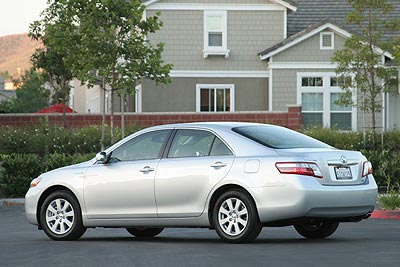
Toyota Camry Hybrid – Driving Impressions: At some point, most everything gets discounted, the regular retail price slashed and likely noted with oversized red numerals and exclamation marks. In early spring, there are sales to clear out excess snow shovels and discounts on lawn furniture to get a head start on the upcoming summer season, which itself follows with selling bonanzas showcasing air conditioners and swimming apparel, or maybe 2-for-1 tickets to the local amusement park. Fall and winter see sales on school necessities and red-tag clearances on anything related to summer. Through it all, car manufacturers and dealers are offering every incentive under the sun to move the metal, an exercise that is becoming increasingly difficult because of one commodity’s unwillingness to decrease in price more than a few pennies every now and again. Gasoline never goes on sale, much to the disdain of SUV, truck, and large sedan-selling dealers everywhere. Unless, of course, they operate under a Toyota sign, which means that sitting next to the V8-powered, four-wheel-drive Tundra pickup is a 2007 Camry Hybrid, a midsize sedan that gets an EPA-estimated 40 mpg in the city, and at just under $31,000 fully loaded, could be considered a bargain even at its retail price. Power for the 192-horsepower 2007 Toyota Camry Hybrid comes from the company’s Hybrid Synergy Drive, the same gas/electric system used in the Prius and Highlander Hybrid SUV. In the Camry version, that includes a 2.4-liter, dual overhead cam, 16-valve four-cylinder engine with variable valve timing. Engine output measures 147 horsepower at 6,000 rpm and 138 lb.-ft. of torque at 4,400 rpm, with the hybrid’s electric motor tacking on about 45 horsepower and 199 lb.-ft. of torque available from 0-1,500 rpm. The hybrid system draws power from a 244.8-volt NiMH (Nickel-Metal Hydride) battery to supplement the gasoline engine and captures braking energy to recharge the battery during deceleration (also known as regenerative braking). Together with an efficient continuously variable automatic transmission delivering power to the front wheels, the SULEV (Super Low Emissions Vehicle) 2007 Toyota Camry Hybrid earns EPA ratings of 40 mpg city and 38 mpg highway, compared to 24/33 for a four-cylinder, gas-powered Camry with a traditional five-speed automatic tranny. We recorded 33.8 mpg over the span of one week, with a slight nod to time spent on the highway. Aside from the hybrid-related technology, this Camry is similar to the rest of the model lineup. Though it weighs about 350 pounds more than a comparable gas-only version, the same front MacPherson strut and rear multi-link suspension controls the ride, with a variable-assist rack-and-pinion steering setup charged with maintaining the intended direction. Bringing 16-inch alloy wheels and 215/60 Bridgestone Potenza tires to a controlled stop are four-wheel antilock disc brakes supported by electronic brake-force distribution and electronic brake assistance systems, as well as Toyota’s Vehicle Dynamics Integrated Management (VDIM) stability control program. In terms of features that the buyer can actually see and touch, the 2007 Toyota Camry Hybrid comes very well equipped for $26,480, including a $580 destination charge. Standard on the one and only available trim are items such as a driver’s knee airbag, front-side airbags, side-curtain airbags, keyless ignition, a power-adjustable driver’s seat, Bluetooth connectivity, electroluminescent gauges, and a 440-watt JBL sound system with a six-disc CD changer capable of playing MP3s and WMAs. That’s not to mention the dual-zone climate control system; a tilt and telescoping leather-wrapped steering wheel with controls for the radio, climate system, and phone (if equipped); a trip computer; a tire pressure monitor; and the handy utility of a split-folding rear bench seat. However, should the Joneses already have the standard Camry Hybrid, you could always go for an example like our $30,667 test car. Besides the $580 destination charge, that price included $1,300 for leather upholstery, $1,200 for a DVD navigation system, $940 for a power sunroof, $470 for a Convenience Package (heated front seats and heated mirrors), and $277 for a Preferred Equipment Package, which amounted to a set of carpeted floor mats, a rear bumper appliqué to prevent scratching, and a first aid kit. Since that amounts to the options list in its entirety, one can quickly deduce that a fully-loaded 2007 Toyota Camry Hybrid will run $30,667. Minus any “special” dealer fees, of course.
Driving Impressions
Toyota Camry Hybrid – Brian Chee’s Driving Impressions: Silence is strange when you’re driving a car. Really – it’s surprising how much we use our ears to drive, to listen to the sound of the engine, the noise that comes up from the tires, the brakes. Even with the radio volume up, your brain fills in the details and tells you what’s going on. Hybrid vehicles knock the whole sweet symphony out of whack. Oh, they make noise. But not the noise we’re used to. They’re quiet when they ought to growl, they instead of grunt, any they whine instead of roar, tossing the driving experience off-kilter and leaving you with an unsettled feeling, unsure whether you just went for a drive or a ride at Disneyland. Shoot, given their real and imagined benefits, hybrids are just plain weird – and I like ‘em. Yet, for all its efforts to fit in with all the other cars out there, the 2007 Toyota Camry Hybrid stays firmly entrenched with the rest of the freaks, a slow-footed sedan that will try your patience at times, scream like a startled bird when you step on it too hard, and generally lose its carefully coiffed composure while traversing a hill. On the freeway and in traffic is where the Camry Hybrid shines, however, silently cruising along at a nice pace, absorbing bumps, and muffling unwanted noise and vibration with Camry-like effectiveness. Brakes perform capably, if a little starchy, while the steering feels good on-center and responsive when the car is in its comfort zone of urban driving, red and green light maneuvering and freeway lane changing. Not a lot of feel for the road here, fellas, so get over it now and remember what it is you’re driving – a Camry with a hybrid powertrain. And about that powertrain: you can barely feel the typical hybrid jolt when you take off. It’s there, but compared to other hybrids it’s barely detectable. To work and back, you’d be hard pressed to find a more comforting ride – that’s sort of like the vehicular equivalent of a polite Brit. Fuel economy is pretty good, if not great, it’s a comfortable sedan that doesn’t pollute, and it makes a killer bread pudding. Cheers, mate! Toyota Camry Hybrid – Ron Perry’s Driving Impressions: With all the buzz about hybrids these days, I was excited to drive the Toyota Camry Hybrid. Some here in the office might call me a cynic (okay, maybe I am a little) but I did keep an open mind during my drive – even though I don’t really see the point of these cars yet. I mean, they don’t surpass a standard car with enough merit for me to bother with one. I wish I could say that with the push of the start button the Camry comes to life, but it doesn’t. In fact, you start to wonder if it is ready to roll until you notice the system check cycling on the gauge pod. When the system check was complete, I sheepishly slipped the car into reverse and cautiously applied the gas to see if anything would happen. Once I felt reverse engage I knew I was on the right track. Right away I concluded that I preferred the normal startup of the Honda Civic Hybrid. Once on the road, I was surprised at the reasonable acceleration the Camry Hybrid produces. It’s no rocket, but does have enough pull to keep up with the flow of traffic. I did feel a slipping/grinding sensation when accelerating away from a stop that really became an annoyance the more I drove the Camry. This feeling alone would prevent me from buying one for use as a daily driver. I just accepted it as a character flaw of the hybrid drivetrain. As I continued my drive, the Camry Hybrid really felt like its gas-powered sibling. The brakes and steering felt good, as did the ride quality. The cabin is quiet and there isn’t the buzziness I experienced from the gas engine at freeway speeds in the standard model. On the freeway, I actually preferred driving the Camry Hybrid over the standard model we had a few weeks back. During my drive the consumption computer stated that fuel economy was 32.7 mpg, not bad but certainly not impressive. For now I think I will stay with the non-hybrid cars – at least I understand how those work. Toyota Camry Hybrid – Thom Blackett’s Driving Impressions: Being a fan of sheer engine power, I probably wouldn’t be the best spokesperson for hybrid vehicles (my fellow college classmates, most of whom were environmentalists, are probably poking needles into a little voodoo doll with my likeness right about now). True, there are muscular models like the Honda Accord Hybrid, but personally I’ve always considered performance hybrids to be oxymoronic. Well, at least those marketed as such. And then I drove the 2007 Toyota Camry Hybrid, a gas/electric variant that I found to be superior to its fossil-fueled brethren. Like most hybrids, a continuously-variable automatic transmission forces the engine to scream up into the high rev range as it doles out the power, but hammer down on the pedal and this vanilla family sedan will actually move with some authority. There’s not a tremendous amount of gusto on takeoff, but mid-range power is surprising, so much so that I was able to make multi-car, high-speed passes on a return trip from central California’s Hearst Castle. I wouldn’t have dared attempt such a move in the Honda Civic Hybrid that we tested the same week. Both the Civic and Camry are supposed to travel at slow speeds solely on electric power, yet I was only successful in getting the Camry up to 20 mph (acting as though there was an eggshell behind the accelerator) before feeling the gas engine kick in. The entire trip up and down the coast covered nearly 500 miles, much of it at high-speeds, so an average of 33.4 mpg was acceptable in my eyes. No, those aren’t great numbers for a hybrid, but I dare say they’re better than I would have seen in a regular Camry under the same conditions, and are due in large part to an aggressive right foot. Admittedly, those hundreds of miles afforded me the time to fully appreciate the 2007 Toyota Camry Hybrid’s powertrain, yet they also brought some sore points to the surface. The brakes had a tendency to be effective, at one point causing me to lock ‘em up because of difficulty with modulation. And the ride, while compliant, is a bit soft, accented by Bridgestone Turanza tires that like to squeal.
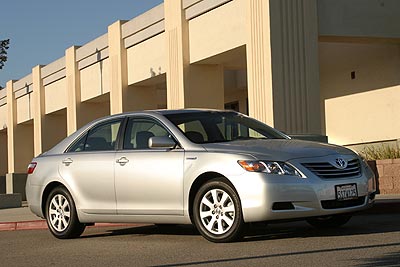
Comfort
Toyota Camry Hybrid – Brian Chee’s Opinion of the Comfort: As comfortable as a dog under a shade tree on a miserably hot day, the Camry Hybrid maintains the Camry’s legacy for being one of the more appealing mainstream rides on the road. As part of an extensive redesign, the Camry Hybrid’s interior is largely the same as the rest of the family, except for upgrades in materials and the inclusion of a Plasmacluster, which is supposed to filter out all the nasty little bits floating around in the air. It’s a thoroughly upgraded affair, with more room compared to the outgoing Camry and space that feels competitive with most of its main competitors. So, overall, it’s comfortable, with a good amount of leg and head room. Only one little complaint – okay, two: First, there could be more room for your feet up front, and wide bodied people may have trouble in the seats. Second, as one of the most expensive Camrys you can buy – just a notch under the XLE V6 – the interior ought to be closer to the Lexus standard. It’s nice – but not that nice. Toyota Camry Hybrid – Ron Perry’s Opinion of the Comfort: The Camry Hybrid seems quieter than the standard Camry, which enhanced my driving experience. Outside of the quietness, the rest of the car felt just like the standard model. The seating is comfortable, though I would enjoy a bit more bolstering. The interior offers lots of room both front and back as well as a comfortable entry and exit. In the standard model I felt the ride quality was a bit stiff but didn’t experience the same result with the Camry Hybrid. Overall, I preferred driving the Camry Hybrid thanks to the quieter interior and seemingly smoother ride. Toyota Camry Hybrid – Thom Blackett’s Opinion of the Comfort: A few years ago I had the opportunity to drive a 2004 Toyota Camry from Maine to Florida. After two and a half days and 1,500 miles, one thing was clear – my back ached. My co-pilot agreed, and soon traded the Camry for something else. Putting in 500 miles behind the wheel of a 2007 Camry Hybrid was like déjà vu. At first, the front bucket feels supportive and comfortable, allowing for proper positioning with multiple power adjustments including lumbar. But after awhile, no adjustments were able to lessen the muscle fatigue I felt in my back. As a road-trip fan, this fact alone would make me thoroughly evaluate the competition. Somewhat offsetting the lack of comfort in the front seats were the tilt and telescoping leather-wrapped steering wheel, the large padded center armrest, and the soft window sills and armrests on the door panels. Rear passengers are treated to a spacious split-bench seat with a reclined seatback, two small cupholders in the center armrest, adjustable vents, and plenty of overall room. Entry and exit are easy.

Quality
Toyota Camry Hybrid – Brian Chee’s Opinion of the Quality: The Camry Hybrid’s quality is great, for some automakers, but perhaps a notch below common standards for Toyota, a brand that has rocketed up the sales charts because of its “quality” reputation. The materials were very nice, and durable, but cabin construction was slightly flawed with loose bits here and there, and slightly misaligned dash areas. On the outside, gaps were consistent and the little things – trim tacked on properly, edges of metal and plastic meeting flush around lights – looked pretty good. And though most people will scarcely notice some of the slight variations, and, yes – we might be a little more exacting in terms of reviewing Toyota’s quality – it’s worth it to take a look at the model you drive and test the knobs and doors inside the cabin, and make sure that you’re satisfied with the soft touch materials around occupants. Toyota Camry Hybrid – Ron Perry’s Opinion of the Quality: For whatever reason, the hybrid version of the Toyota Camry seemed to have much better exterior build quality than the standard model we tested recently. Outside panel fitment on this hybrid was tight and precise with none of the varying seams found on our previous Camry test car. Inside, however, fitment issues still existed. Loose A-pillar covers, gaps where the A-pillars met the headliner, misaligned panels where the dash wraps around the gauges, poor glove box fitment, and poor panel alignment where the vents and center console meet were all still evident. Toyota Camry Hybrid – Thom Blackett’s Opinion of the Quality: As was the case with the 2007 Toyota Camry we recently had in the shop, this Camry Hybrid packed quality issues. In particular, the padded dash cap didn’t sit flush with the side vents, the speaker atop the dash was out of line with the rest of the panels, the A-pillar covers were loose, casting flash from the manufacturing process were visible on many of the plastics, there was an annoying rattle coming from the dash, and there were uneven gaps around and below the instrument cluster. All told, the interior looked like a rush job, at least by what we’ve come to know as Toyota standards. Materials were marginally better. Our test car included optional leather seats that felt durable but cheap, a soft padded dash cap, and hard plastic used liberally throughout the cabin. Curiously, the pillar covers featured a plastic grain meant to mimic mesh (such as a mesh headliner), yet a fuzzy headliner was tacked in overhead.
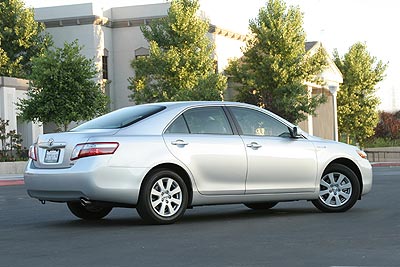
Design
Toyota Camry Hybrid – Brian Chee’s Opinion of the Design: I like it. I really like it, though I’ll lay a bet that many auto journalists will see it differently. Oh, they’ll trot out those old Toyota rants about boring styling and blah inspiration. To them I say just one thing: look at that snout! It’s a thing of beauty, the way the hood rakes down into that aggressive grille and oversized badge. The sheetmetal, while not rakishly dandy, is modern and well ahead of most of its import peers (Honda, Hyundai) in terms of an up-tempo and more aggressive style. Case in point: the back, with its angled taillights, is nicely modern. Inside, it’s your typical Camry – changes compared to your run of the mill Camry are confined to the front layout, with Plasmacluster included, and a trendy, greenish color scheme. With two vents up top, and the stereo and environmental controls logically spaced out, the Camry Hybrid is well-executed, thoughtful and intuitive, and everything is presented exactly where the driver and passengers assume. Toyota Camry Hybrid – Ron Perry’s Opinion of the Design: Not much to write about here since the design is the same, with just a couple of hybrid badges attached to the top of the front fenders. I could live without them, but I guess since driving a hybrid these days is looked on as stylish and cool, most drivers will want them to be noticed. Noticeably missing from the Camry Hybrid was wood interior trim, which is replaced with an aluminum-look trim. The look flows better with the colored console fascia but lacks the warmth the wood carries. Toyota Camry Hybrid – Thom Blackett’s Opinion of the Design: Very little separates the 2007 Toyota Camry Hybrid from its gas-only counterpart, aside from a few unique badges. That is to say, I’m not fond of this car’s styling either. The dimensions seem out of sync, the raised front fenders look odd from certain angles, and the tail end features the tiered treatment that was so hated when first introduced years ago by BMW. Further dampening any enthusiasm I might have garnered for this car was its drab gray interior – the blue gauges and instrument panel weren’t enough to swing my vote.
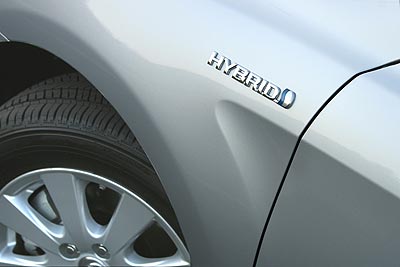
Advice
Toyota Camry Hybrid – Brian Chee’s Advice: With a strong Camry appeal, an above average fuel economy rating of 33 mpg, plus the clean factor of driving a vehicle that spews out virtually zero pollutants, the 2007 Toyota Camry Hybrid looks to be a strong contender for those interested in buying a $26,000 or more sedan. But with buyers of the Prius still on waiting lists, the real home run would have been to offer the hybrid powertrain across all Camry V6 trims – meaning $3,000 less for a $22,000 Camry LE with Hybrid option. Toyota’s strength, after all, is making cars that appeal to many people, and it’s my opinion that at $26,000 – this car is too expensive for many Camry shoppers. With dealer markup and the rest, it’s a shame that the Camry masses really can’t afford one of the most advanced Toyotas ever. Toyota Camry Hybrid – Ron Perry’s Advice: Overall, my experience in the Camry Hybrid was a good one so I would have to recommend you test drive one if you are in the market for a hybrid. Definitely sit down and figure out if the gas savings will compensate for the higher price of the car and whether or not you can live with slower acceleration. These are important considerations and shouldn’t be considered lightly. What you feel you can live with today might, over time, become a nuisance. I personally couldn’t live with the acceleration compared to the lively feel of the standard Camry V6, but I do lots of freeway driving where acceleration is needed and appreciated. Toyota Camry Hybrid – Thom Blackett’s Advice: This is a tough one. On one hand, the 2007 Toyota Camry Hybrid is surprisingly lively and can be driven quickly while still returning admirable fuel economy, at least for this size of vehicle. On the other hand, I think about the iffy build quality and my aching back. Maybe the example on your local lot was paid more attention before being shipped, and maybe your back is more forgiving than mine.
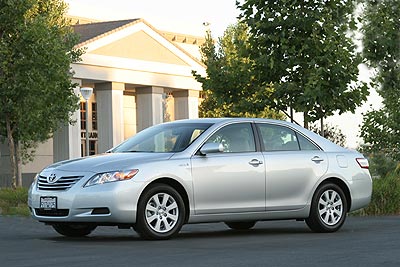
Specifications
Test Vehicle: 2007 Toyota Camry Hybrid Price of Test Vehicle: $30,667 (including a $580 destination charge) Gasoline Engine Size and Type: 2.4-liter inline four cylinder Gasoline Engine Horsepower: 147 at 6,000 rpm Gasoline Engine Torque: 138 lb.-ft. at 4,400 rpm Electric Motor Size and Type: Permanent magnet with 244.8-volt Nickel-Metal Hydride (Ni-MH) battery Electric Motor Horsepower: 40 at 4,500 rpm Electric Motor Torque: 199 lb.-ft. between 0 and 1,500 rpm Combined Horsepower Rating: 187 Transmission: Continuously-variable automatic Curb weight, lbs.: 3,637 EPA Fuel Economy (city/highway): 40/38 mpg Observed Fuel Economy: 33.7 mpg Length: 189.2 inches Width: 71.7 inches Wheelbase: 109.3 inches Height: 57.5 inches Leg room (front/rear): 41.6/38.3 inches Head room (front/rear): 38.8/37.8 inches Max. Seating Capacity: Five Max. Cargo Volume: 10.6 cubic feet Competitors: Honda Accord Hybrid Honda Civic Hybrid Toyota Prius
Photos by Ron Perry
